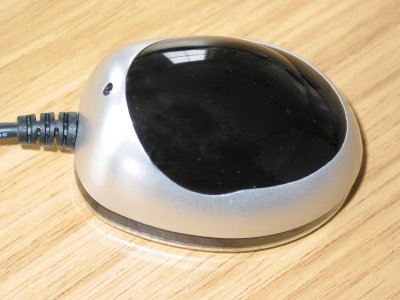|

Introduction
TFAC stands for the Taiwan Falcon Aerospace Corporation and they are a relatively new
name to be seen in Europe and North America. TFAC have been going for
quite some time, designing GPS boards mainly for GLONASS (the Russian Global
Positioning System), but they recently ventured into GPS Retail by creating
several new GPS Receivers for the NavStar constellation, the one we are reviewing
here is the TFAC MG 30. This is a mouse type GPS Receiver, with a PS/2
connection plug/socket and terminates in an accessory plug to be powered in-car.

TFAC are going to be on a winner with this design,
the receiver looks pretty sexy! We've seen some nice designed receivers
over the past year, but this one reminds me of a futuristic space buggy.
The receiver is hidden behind the black domed Perspex, and above this (left)
there is an LED to signify power and satellite acquisition.
Seeing that a lot of GPS receivers are now coming
with a PS/2 connection, in theory providing the pin-outs are the same throughout
(no reason why not), then you should be able to pick up additional cables quite
cheaply. The cable terminates in a Y connector like most GPS Receivers,
and the accessory plug will power the GPS Receiver and charge the Pocket PC at
the same time.
One of the great things about the MGL 30 is it's
completely waterproof, unlike a lot of GPS mouse receivers. The MG 30 comes with
a magnetic base, so if you wanted to place it on the roof of a car, you won't
have any worries here. One of the downsides about this receiver is the
base doesn't have a felt pad (which is something that a lot of manufacturers
forget. Which means if you want to place this on the
dashboard, it will slip and slide around, unless you anchor it down with sticky
back 3M pad or some double sided velcro (not supplied).
The MG 30 can be used both on a PC and PDA.
Cable sets are available terminating in a 9 pin RS232 Serial connector, USB
connector and also various PDA's including the 3600/3800/5400/2200/1900 range of
Compaq/HP iPAQ connectors. The serial connector comes with a model type of
MG-30R, the USB as a MG-30U.

Features
-
12 channel in parallel
-
L1, C/A code
-
Operating with low power
-
Operating with 5V
-
Serial, USB or PDA cable sets
-
Easy use
-
Fast start0up
-
NMEA 0183 data communication protocol supported
-
Built-in antenna
-
Built-in data recorder (MGL-30)
-
Support software
-
Light and handy shape
-
Waterproof enclosure
Technical Specification
-
Position Accuracy (15 meters CEP, without SA)
-
Velocity Accuracy (0.1 meters/second, without SA)
-
Max Speed (515 meters/sec / 1000 Knots)
-
Acceleration (4g max)
-
Jerk (20 meters/sec - 3 max)
-
Max Altitude (18,000 meters or 60,000 feet)
-
TTFF Cold (45 seconds)
-
TTFF Warm (8 Seconds)
-
TTFF Hot (0.1 Seconds)
-
Update Rate (1 Second)
-
Receiver Sensitivity (-172dBW)
-
Map Datum Supported (WGS-84)
How well does the TFAC Receiver respond ?
The TFAC MG 30 responds very well.
TTFF's are a little slow, the fastest TTFF we received from cold was 1m 17s, and
the slowest 2m 11s, bringing the average cold TTFF to 1minute 37seconds, which
is slower than the average GPS mouse when compared to a Leadtek, Holux or
Sapphire, but when the TFAC locks onto a 3D fix, it won't let go! This is
one of the most important factors when choosing a GPS, TTFF is important and
it's one you'll encounter every day, but there's not much use having a GPS
receiver that will lose fix every 30 seconds, and the TFAC performed very well.
Re-acquisition time is also very fast (difficult to time), so if you did lose
signal through heavy foliage, expect to get a signal back very quickly!
|